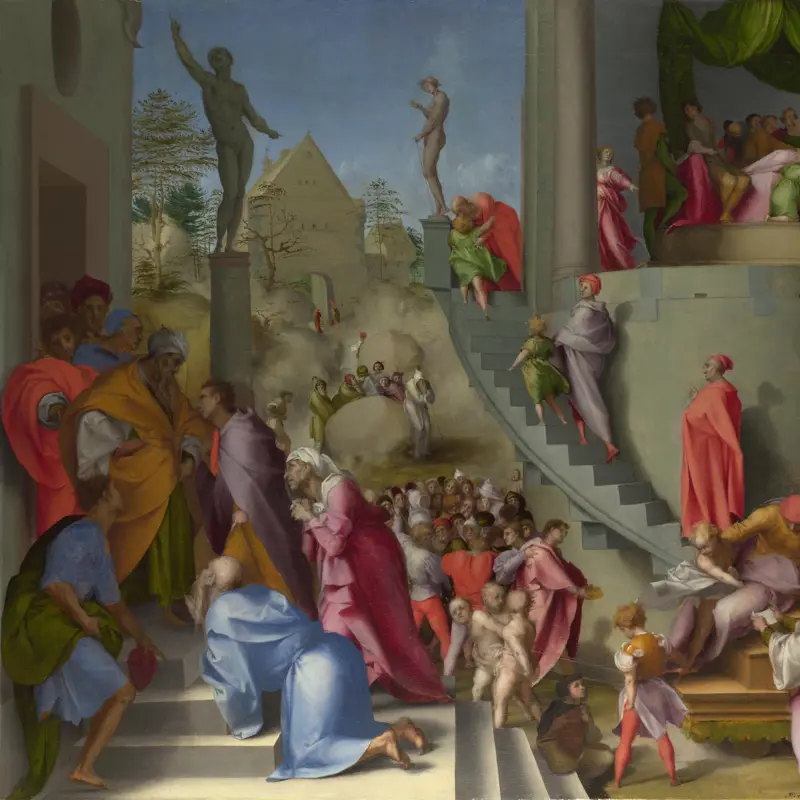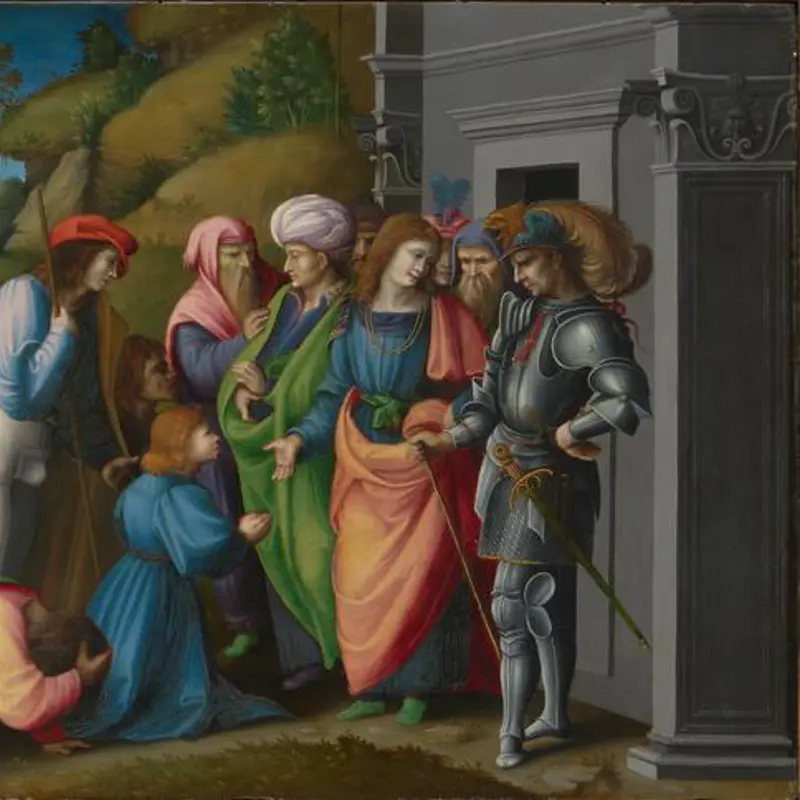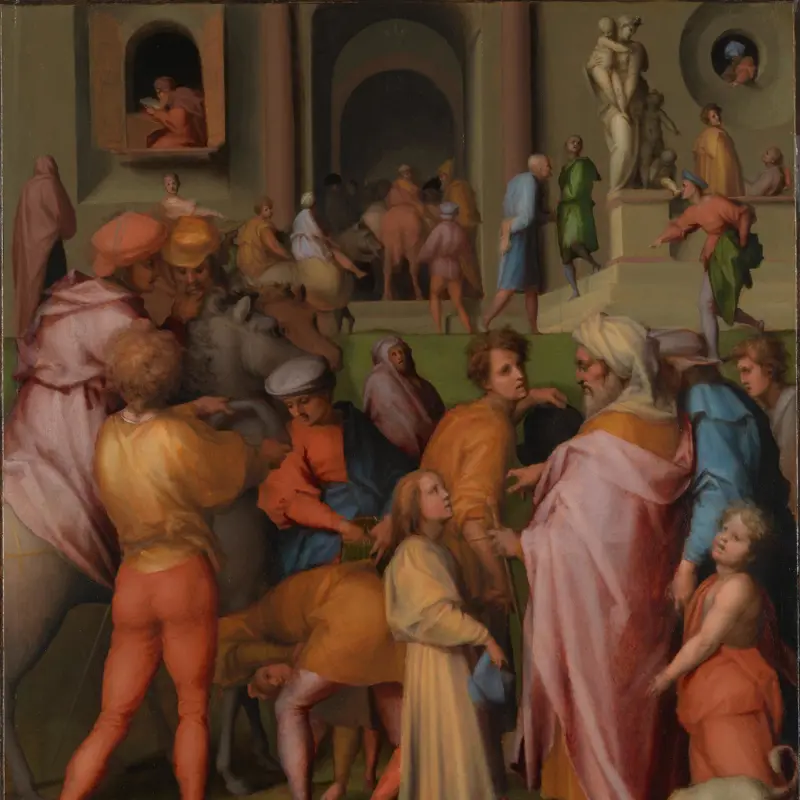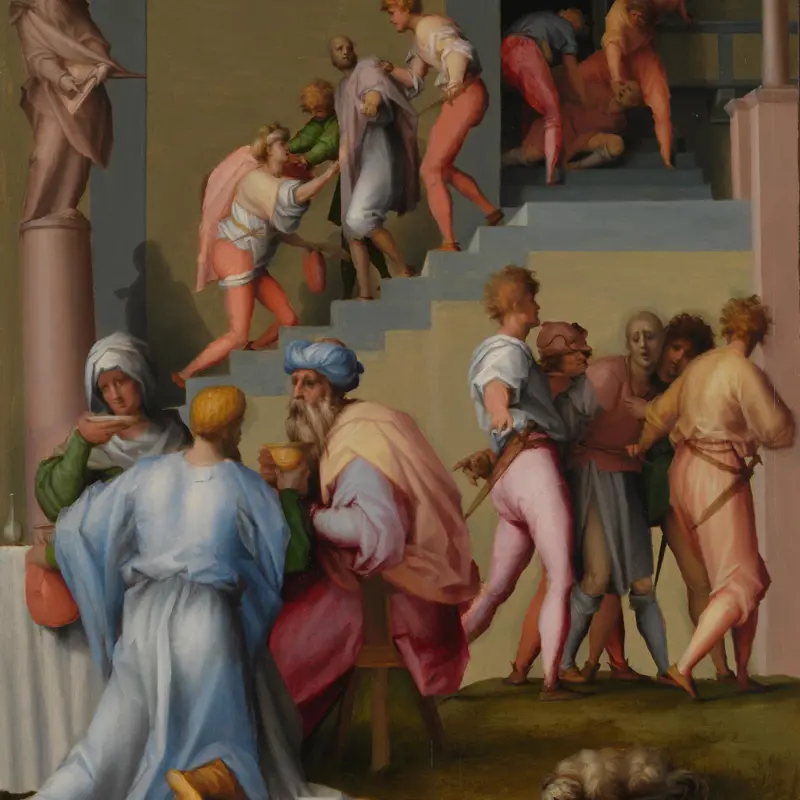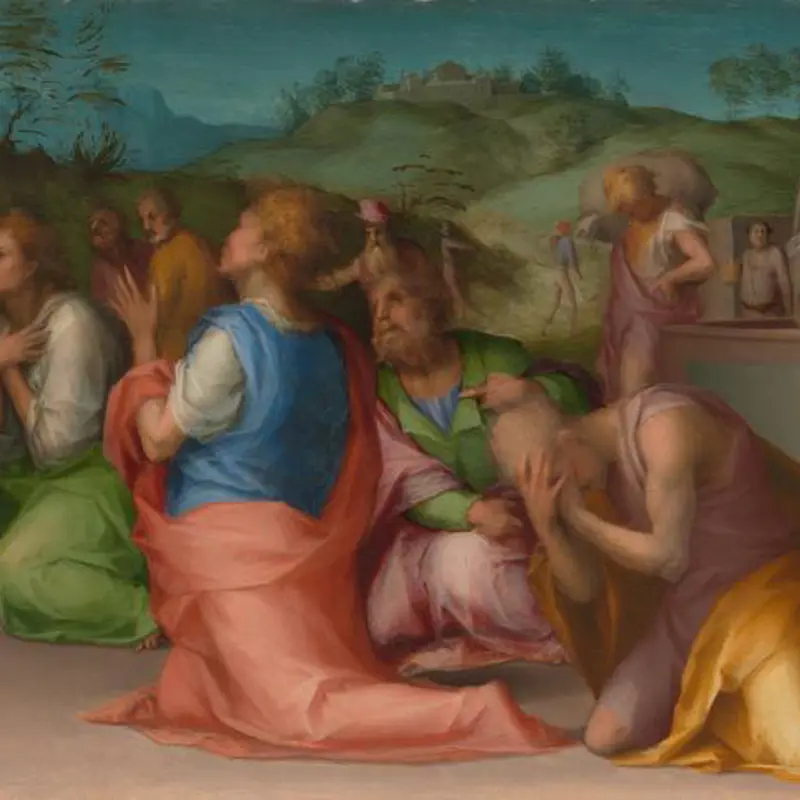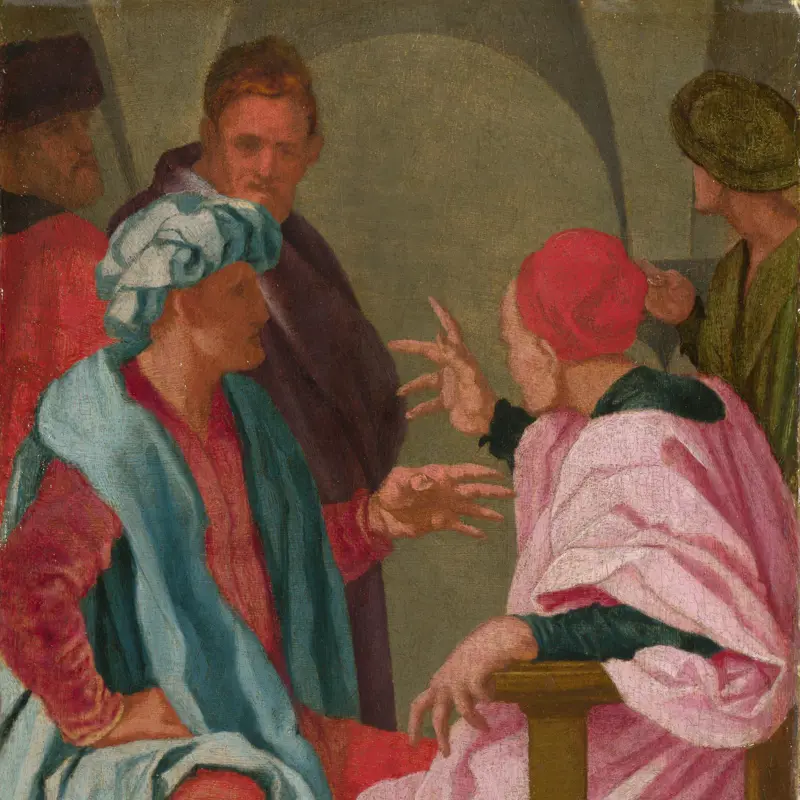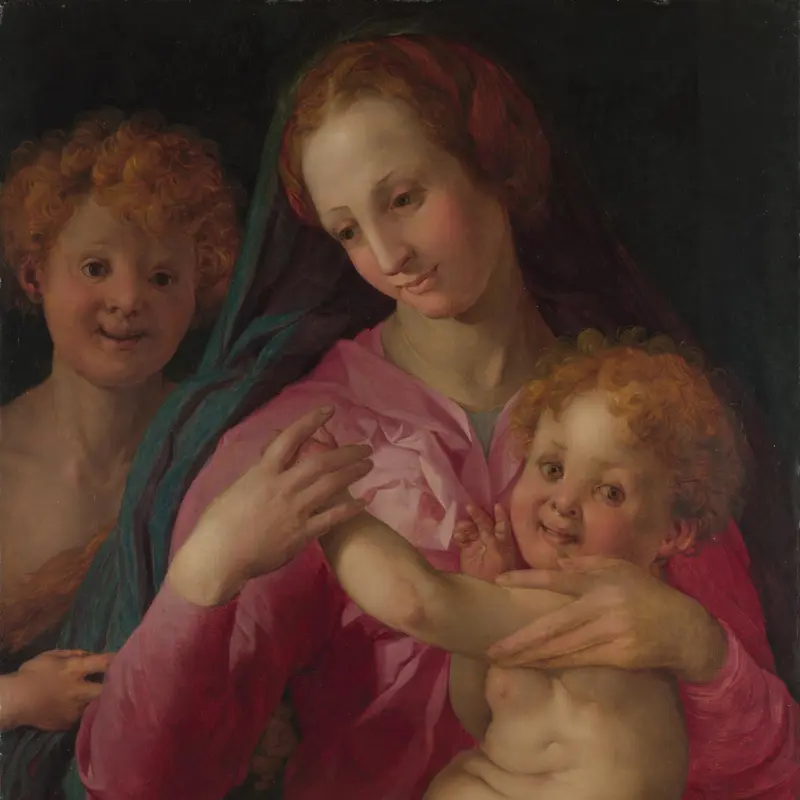Pontormo, 'Joseph with Jacob in Egypt', probably 1518
About the work
Overview
This was the latest and most advanced of a series of panels that were made to decorate the bedchamber of the Florentine banker Pierfrancesco Borgherini on the occasion of his marriage in 1515. The paintings, commissioned by Pierfrancesco’s father, tell the Old Testament story of Joseph. Five other panels from the series are in the National Gallery’s collection.
In this picture (which may not have been part of the original commission) the concluding episodes of the story of Joseph and Jacob are ingeniously condensed. There are four separate moments combined here: Joseph introducing his father Jacob to the Pharaoh of Egypt; Joseph on a chariot, hearing a petition from the victims of famine; Joseph with his sons climbing the staircase to visit the dying Jacob; and Jacob blessing Joseph’s sons.
This type of picture, in which several parts of a story are shown simultaneously, is known as a continuous narrative and was particularly popular for furniture decoration.
Key facts
Details
- Full title
- Joseph with Jacob in Egypt
- Artist
- Pontormo
- Artist dates
- 1494 - 1556/7
- Part of the series
- Scenes from the Story of Joseph
- Date made
- Probably 1518
- Medium and support
- Oil on wood
- Dimensions
- 96.5 × 109.5 cm
- Acquisition credit
- Bought, 1882
- Inventory number
- NG1131
- Location
- Room 7
- Collection
- Main Collection
- Frame
- 16th-century Italian Frame
Provenance
Additional information
Text extracted from the ‘Provenance’ section of the catalogue entry in Cecil Gould, ‘National Gallery Catalogues: The Sixteenth Century Italian Schools’, London 1987; for further information, see the full catalogue entry.
Bibliography
-
1854G.F. Waagen, Treasures of Art in Great Britain: Being and Account of the Chief Collections of Paintings, Drawings, Sculptures, Illuminated Mss. […], vol. 2, trans. E. Eastlake, London 1854
-
1882'The New Pictures in the National Gallery', The Athenaeum, 1882
-
1882C. Monkhouse, 'The Hamilton Collection', Art Journal, 1882
-
1882J.P. Richter, 'Pontormo's Picture from Hamilton Palace in the National Gallery', The Academy, XXII, 1882
-
1882Christie, Manson & Woods, Catalogue of the Collection of Pictures, Works of Art, and Decorative Objects, the Property of His Grace the Duke of Hamilton, K.T., London, 17 June 1882 - 20 July 1882
-
1962Gould, Cecil, National Gallery Catalogues: The Sixteenth Century Italian Schools (excluding the Venetian), London 1962
-
1964C. Onofrio, 'Inventario dei dipinti del Cardinal Pietro Aldobrandini, compilato da G.B. Agucchi nel 1603', Palatino, VIII, 1964, pp. 15-20, 158-62, 202-11
-
1975C. Gould, Delaroche and Gautier: Gautier's Views on the 'Execution of Lady Jane Grey' and on other Compositions by Delaroche, London 1975
-
1981C. McCorquodale, Bronzino, London 1981
-
1983J. Mills and R. White, 'Analyses of Paint Media', National Gallery Technical Bulletin, VII, 1983, pp. 65-7
-
1987Gould, Cecil, National Gallery Catalogues: The Sixteenth Century Italian Schools, London 1987
-
1995E.H. Gombrich, Shadows: The Depiction of Cast Shadows in Western Art (exh. cat. The National Gallery, 26 April - 18 June 1995), London 1995
-
2001
C. Baker and T. Henry, The National Gallery: Complete Illustrated Catalogue, London 2001
-
2001V. Ficklin, 'Mannerist Staircases: A Twist in the Tale', Athanor, XIX, 2001, pp. 27-33
-
2002C. Plazzotta and R. Billinge, 'The Underdrawing of Pontormo's "Joseph with Jacob in Egypt"', The Burlington Magazine, CXLIV/1196, 2002, pp. 660-70
-
2002D. Bomford et al., Underdrawings in Renaissance Paintings (exh. cat. The National Gallery, 30 October 2002 - 16 February 2003), London 2002
-
2002S. Lugon, 'Vers une nouvelle conscience de la peinture: La trace de l'artiste dans Joseph en Egypte de Pontormo', Annales d'histoire de l'art et d'archeologie, XXIV, 2002, pp. 51-71
-
2004R. Verdi, Bartholomeus Breenbergh (1598-1657): Joseph distributing corn in Egypt (exh. cat. The Barber Institute of Fine Arts, 29 October 2004 - 23 January 2005; Bredius Museum, 12 February - 1 May 2005), Birmingham 2004
-
2005L. Boubli, 'L'élégance et la grâce: Ornatus et Belle Manière', Revue de l'art, 148, 2005, pp. 15-40
-
2005J. Cox-Rearick, 'Jacopo da Pontormo, Pontormo 1494-Firenze 1556: Study of a Boy seen from behind, his Face almost in Profile; his Left Hand Restudied in the Upper Right Corner', in P. Costamagna, F. Harb and S. Prosperi Valenti Rodino (eds), Disegno, giudizio e bella maniera: Studi sul disegno italiano in onore di Catherine Monbeig Goguel, Milan 2005
About this record
If you know more about this work or have spotted an error, please contact us. Please note that exhibition histories are listed from 2009 onwards. Bibliographies may not be complete; more comprehensive information is available in the National Gallery Library.
Images
About the series: Scenes from the Story of Joseph
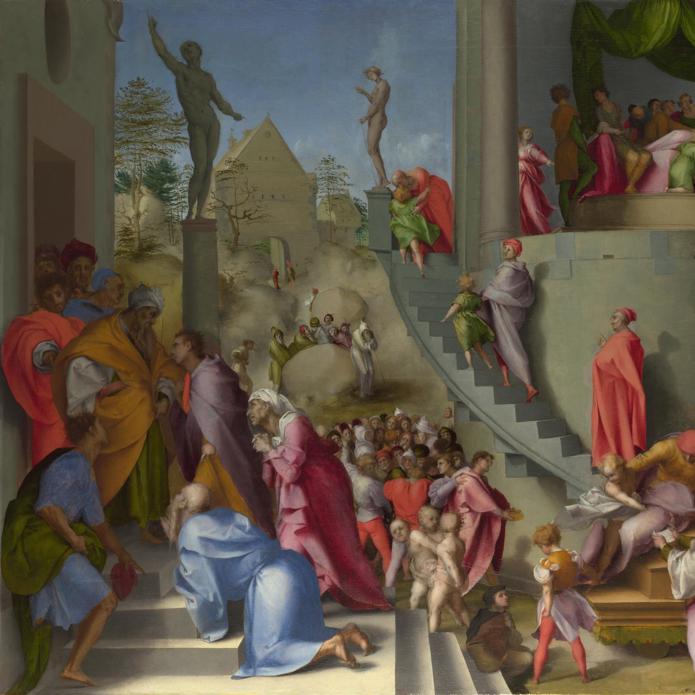
Overview
These six pictures by Pontormo and Bacchiacca were part of a larger series of panel paintings commissioned to celebrate the marriage of Pierfrancesco Borgherini to Margherita Accaiuoli in 1515. The series decorated the couple’s bedroom in the Borgherini palace in Florence. Francesco Granacci and Andrea del Sarto also contributed to the decorative scheme, which would have been one of the most sumptuous of the time. The paintings, telling the story of Joseph from the Old Testament (Genesis 39), would have been set into the wall panelling and furniture.
Pontormo’s interest in the emerging new style known as Mannerism – a reaction against the harmony, proportion and naturalism of High Renaissance art – is evident in his bright colours, disconcertingly unnatural approach to space, elongated figures and spiralling compositions. Bacchiacca’s scenes are expressive and dramatic but stylistically more conventional.

